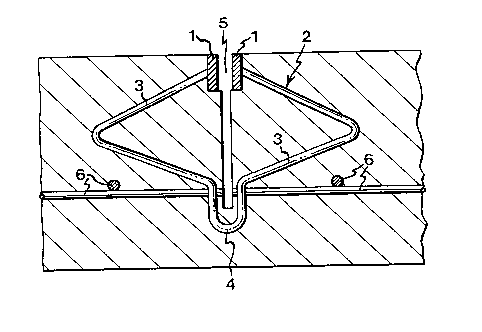Some of the information on this Web page has been provided by external sources. The Government of Canada is not responsible for the accuracy, reliability or currency of the information supplied by external sources. Users wishing to rely upon this information should consult directly with the source of the information. Content provided by external sources is not subject to official languages, privacy and accessibility requirements.
Any discrepancies in the text and image of the Claims and Abstract are due to differing posting times. Text of the Claims and Abstract are posted:
| (12) Patent Application: | (11) CA 2151964 |
|---|---|
| (54) English Title: | DEVICE FOR JOINTS IN CONCRETE FLOORS |
| (54) French Title: | DISPOSITIF SERVANT POUR LES JOINTS DANS LES PLANCHERS DE BETON |
| Status: | Deemed Abandoned and Beyond the Period of Reinstatement - Pending Response to Notice of Disregarded Communication |
| (51) International Patent Classification (IPC): |
|
|---|---|
| (72) Inventors : |
|
| (73) Owners : |
|
| (71) Applicants : | |
| (74) Agent: | SWABEY OGILVY RENAULT |
| (74) Associate agent: | |
| (45) Issued: | |
| (86) PCT Filing Date: | 1993-11-29 |
| (87) Open to Public Inspection: | 1994-06-23 |
| Availability of licence: | N/A |
| Dedicated to the Public: | N/A |
| (25) Language of filing: | English |
| Patent Cooperation Treaty (PCT): | Yes |
|---|---|
| (86) PCT Filing Number: | PCT/SE1993/001026 |
| (87) International Publication Number: | SE1993001026 |
| (85) National Entry: | 1995-06-15 |
| (30) Application Priority Data: | ||||||
|---|---|---|---|---|---|---|
|
A device for joints in concrete floors is disclosed, comprising edge linings (1) and one or more clasps (2). The clasps (2) and the
edge linings (1) are interconnected in a fixed manner, and each clasp (2) is designed as two laterally projecting arches (3) which join in a
downwardly extending, arcuate projection (4). Moreover, a method for casting concrete floors is disclosed, comprising the steps of casting
the concrete floor on the base and steel trowelling of the concrete surface. The device is pressed down in the concrete before hardening
thereof, whereupon the edge linings (1) are adjusted in the steel trowelling of the concrete surface. The concrete floor is sawn between the
edge linings (1) to a depth which is smaller than the depth of the clasps (2), whereupon the now formed joints are filled with a semi-elastic
compound. Furthermore, means for pressing down or mounting of the device, and a casting method in which the device is mounted in situ
before casting are disclosed.
Note: Claims are shown in the official language in which they were submitted.
Note: Descriptions are shown in the official language in which they were submitted.

2024-08-01:As part of the Next Generation Patents (NGP) transition, the Canadian Patents Database (CPD) now contains a more detailed Event History, which replicates the Event Log of our new back-office solution.
Please note that "Inactive:" events refers to events no longer in use in our new back-office solution.
For a clearer understanding of the status of the application/patent presented on this page, the site Disclaimer , as well as the definitions for Patent , Event History , Maintenance Fee and Payment History should be consulted.
| Description | Date |
|---|---|
| Inactive: IPC from MCD | 2006-03-11 |
| Time Limit for Reversal Expired | 1997-12-01 |
| Application Not Reinstated by Deadline | 1997-12-01 |
| Deemed Abandoned - Failure to Respond to Maintenance Fee Notice | 1996-11-29 |
| Application Published (Open to Public Inspection) | 1994-06-23 |
| Abandonment Date | Reason | Reinstatement Date |
|---|---|---|
| 1996-11-29 |
Note: Records showing the ownership history in alphabetical order.
| Current Owners on Record |
|---|
| SVEN-GUNNAR JONSSON |
| Past Owners on Record |
|---|
| None |